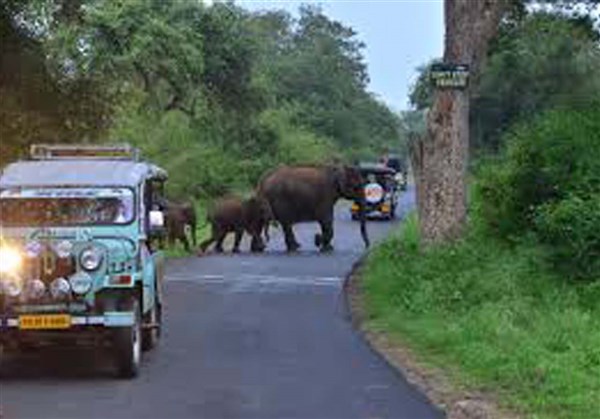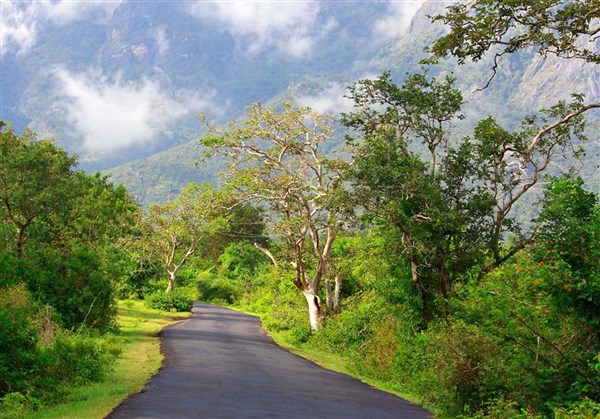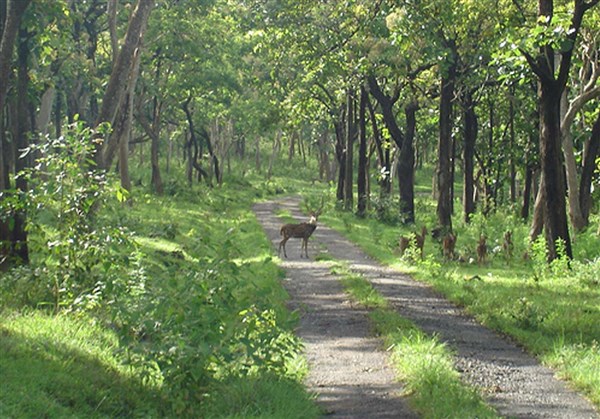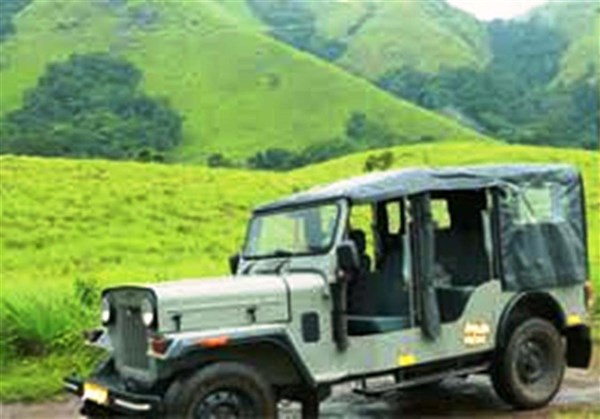About Mudumalai National Park, Masinagudi
Students Tour packges Students Tours Eductional tours Students tours Eductional tours Students tour packages College tours study tours college tour packages for students
Mudumalai Wildlife Sanctuary & National Park is situated at the tri-junction of Tamil Nadu, Kerala and Karnataka on the North Eastern Slopes of the Nilgiris part of Western Ghats descending to the Mysore Plateau. An erstwhile game reserve, Mudumalai was declared a wildlife sanctuary with a 62 sq KM area in the early 1940 by the then Madras Presidency. With Bandipur Tiger Reserve (Karnataka) in the north and Wynad Wildlife Sanctuary (Kerala) in the west the region forms a single, continuous viable habitat for a varied range of wildlife and is a part of the Nilgiri Biosphere Reserve. While Mudumalai western half receives the southwest monsoon, the eastern tracts receive the relatively gentler north-east monsoon which results in a diversity of vegetation types and typical migration of herbivores.
Family Tour packges Family Tours Lisure Tour Family tours Family tour Family tour packages Family tours Family tour Family tour package for Family Packages for Families
Situated in the Nilgiri Hills of Tamil Nadu, Mudumalai is flanked by Bandipur Tiger Reserve and Wynad Wildlife Sanctuary. This contiguous forest, forming one of the most extensive ranges for the Asiatic Elephant, is a part of the Nilgiri Biosphere Reserve and covers an area of approximately 2000 sq.km. With its varied topography and rainfall pattern from West to East, this Park has vegetation types ranging from moist deciduous to dry deciduous and dry thorn forests. Mudumalai is best known for its Elephants and herds of these are quite commonly seen along the National Highway which bifurcates the Park. Other mammals commonly encountered are Gaur, Chital, Sambar, Muntjac, Wild Boar, Common Langur, Bonnet Macaques, and Giant Squirrels. The Dhole is the most visible predator and is found in packs varying from 2 to 25 individuals. The Sanctuary is open throughout the year, but the monsoon months are best avoided and also the driest months of April and May, when the Park staff are engaged in fire fighting.
Corporate Tour packges Corporate Tours Corporate Tours Corporate tours Corporate tour Corporate tour packages Corporate tour Corporate tour Corporate tour for Corporate
The Mudumalai National Park and Wildlife Sanctuary also a declared Tiger Reserve, lies on the northwestern side of the Nilgiri Hills (Blue Mountains), in Nilgiri District, about 150 km (93 mi) north-west of Coimbatore city in Kongu Nadu region of Tamil Nadu. It shares its boundaries with the states of Karnataka and Kerala. The sanctuary is divided into 5 ranges – Masinagudi, Theppakadu, Mudumalai, Kargudi and Nellakota.
LTA LTC Tour packges LTA LTC Tours LTA LTC tours LTA LTC tours LTA LTC tours LTA LTC tour packages LTA LTC tours LTA LTC tours LTA LTC tour packages for LTA LTC
The protected area is home to several endangered and vulnerable species including Indian elephant, Bengal Tiger, Gaur and Indian Leopard. There are at least 266 species of birds in the sanctuary, including critically endangered Indian White-rumped Vulture and long-billed vulture.
Students Tour packges Students Tours Eductional tours Students tours Eductional tours Students tour packages College tours study tours college tour packages for students
The Western Ghats, Nilgiri Sub-Cluster (6,000 km2 (2,300 sq mi)), including all of Mudumalai National Park, is under consideration by the UNESCO World Heritage Committee for selection as a World Heritage Site.
Family Tour packges Family Tours Lisure Tour Family tours Family tour Family tour packages Family tours Family tour Family tour package for Family Packages for Families
Mudumalai has a rich and varied history. These teak-rich forests were originally temple property (belonging to the Raja of the Nilambur). Logging began here in the early nineteenth century when it was leased to timber merchants. The lease was transferred to the Government in 1862 for a reported annual rent of just Rs.3500/- In 1914 Mudumalai became State Government property and in 1927 it was declared a Reserve Forest.
Corporate Tour packges Corporate Tours Corporate Tours Corporate tours Corporate tour Corporate tour packages Corporate tour Corporate tour Corporate tour for Corporate
The first step towards protection was initiated in 1940 when an area of approximately 60sq.km was declared a Wildlife Sanctuary. The Second World War, however, intervened and a jungle warfare training camp was established here to prepare troops for the fighting in Burma. The remnants of this can still be seen today and has reportedly been used by Wild Dogs whilst shifting dens with their pups. In 1977, Mudumalai along with a part of the Sigur Range was reorganized as a Wildlife Sanctuary covering a total area of 321 sq.km.
LTA LTC Tour packges LTA LTC Tours LTA LTC tours LTA LTC tours LTA LTC tours LTA LTC tour packages LTA LTC tours LTA LTC tours LTA LTC tour packages for LTA LTC
This tract is drained by the Moyar, which flows through the Sanctuary and then turns east to form the northern boundary between Mudumalai and Bandipur. The Mysore - Udhagamandalam (Ootacamund) highway that runs north to south splits the Park.
Students Tour packges Students Tours Eductional tours Students tours Eductional tours Students tour packages College tours study tours college tour packages for students
Mudumalai is situated in the Nilgiri Hills of the state of Tamil Nadu and is bordered by Bandipura Tiger Reserve to the north and Wynad Wildlife Sanctuary to the west. This contiguous forest, forming one of the finest and most extensive ranges for the Asiatic Elephant, is a part of the Nilgiri Biosphere Reserve and covers an area of approximately 2000 sq.km
Family Tour packges Family Tours Lisure Tour Family tours Family tour Family tour packages Family tours Family tour Family tour package for Family Packages for Families
Mudumalai receives most of its rainfall from the South West monsoon which commences in May and continues till September/October. The Northeast monsoon also causes some precipitation, but this is very light. Due to the topography, the amount of rainfall varies through the area, with the western part of the Sanctuary receiving heavy precipitation but the eastern part, lying in the rain shadow, receiving considerably less. This results in a strong west-east gradient, with average rainfall ranging from 2300 mm-900 mm. (90-35 inches)
Corporate Tour packges Corporate Tours Corporate Tours Corporate tours Corporate tour Corporate tour packages Corporate tour Corporate tour Corporate tour for Corporate
Temperatures range from 14°C (57.2°F) to 35°C(95°F) with the coldest month being January and the hottest, May
LTA LTC Tour packges LTA LTC Tours LTA LTC tours LTA LTC tours LTA LTC tours LTA LTC tour packages LTA LTC tours LTA LTC tours LTA LTC tour packages for LTA LTC
The Mudumalai Sanctuary is as an important wildlife habitat due to its strategic position as Wildlife between several other protected areas that are a part of the Nilgiri Biosphere Reserve. To the north is the Bandipur National Park and Nagarhole National Park. To the west is the Wayanad Wildlife Sanctuary and in the south are Mukurthi National Park and Silent Valley National Park. To the east is the Sigur Plateau which connects to the Satyamangalam wildlife sanctuary and Reserve forests and Biligirirangan Hills Wildlife Sanctuary. These parks, sanctuaries and the adjoining Reserve forests cover over 3,300 square kilometres (1,300 sq mi) of forest supporting a population of 1800–2300 elephants.
Students Tour packges Students Tours Eductional tours Students tours Eductional tours Students tour packages College tours study tours college tour packages for students
The elevation of the sanctuary varies from a minimum of 960 metres (3,150 ft) m to a maximum of 1,266 metres (4,154 ft). The sanctuary has a tropical savanna climate or tropical wet and dry climate that corresponding to the categories Aw and As of the Köppen climate classification. Rainfall ranges from 790 mm (31 in) to 2,000 mm (79 in).
Family Tour packges Family Tours Lisure Tour Family tours Family tour Family tour packages Family tours Family tour Family tour package for Family Packages for Families
Mudumalai Tiger Reserve
Corporate Tour packges Corporate Tours Corporate Tours Corporate tours Corporate tour Corporate tour packages Corporate tour Corporate tour Corporate tour for Corporate
There are 48 tigers in the Nilgiri Reserve across which tigers are free to roam. In April 2007, the Tamil Nadu state government declared Mudumalai as a Tiger Reserve, under section 38V of the Wildlife, in an effort to conserve the country's dwindling Tiger populations. Subsequently, about 350 families living in the core area have been evicted from the park and given 1 million rupee ($20,800) compensation. Those in the 5 km buffer area around the park fear they too will be evicted; however, nobody will be dislodged from the buffer zone. In fact, some people in this zone will be involved in the project as trackers and guides to enhance their income through eco-tourism.
LTA LTC Tour packges LTA LTC Tours LTA LTC tours LTA LTC tours LTA LTC tours LTA LTC tour packages LTA LTC tours LTA LTC tours LTA LTC tour packages for LTA LTC
Continuance of Project Tiger’ in Mudumalai Tiger Reserve for FY 2010/11, at the cost of Rs.40 million, was approved by the National Tiger Conservation Authority on 16 September 2010.
Students Tour packges Students Tours Eductional tours Students tours Eductional tours Students tour packages College tours study tours college tour packages for students
There are three main types of forest in the sanctuary: tropical moist deciduous occur in the western Benne Block, where rainfall is higher than in the other blocks. Tropical dry deciduous forest occurs in the middle and southern tropical dry thorn forests are in the east.
Family Tour packges Family Tours Lisure Tour Family tours Family tour Family tour packages Family tours Family tour Family tour package for Family Packages for Families
In addition there are patches of tropical semi ever green forest in the Southwest and Western part of Mudumalai. The annual rainfall there exceeds 2,000 mm (79 in).
Corporate Tour packges Corporate Tours Corporate Tours Corporate tours Corporate tour Corporate tour packages Corporate tour Corporate tour Corporate tour for Corporate
Tree species in this habitat include Casseria ovoides, Litsea mysorensis, Cinnamomum malabatrum andOlea dioca. Climbers including Sneeze Wort (Watakaka volubilis), Gnetum ula and Entada scandens are also found in these semi evergreen forests.
LTA LTC Tour packges LTA LTC Tours LTA LTC tours LTA LTC tours LTA LTC tours LTA LTC tour packages LTA LTC tours LTA LTC tours LTA LTC tour packages for LTA LTC
Moist Bamboo brakes are found amidst dry deciduous, moist deciduous and semi-evergreen forests and along the fringes of riparian forests and swamps. There are two species of bamboo found in Mudumalai, the giant clumping bamboos: Bambusa (arundinacea) andDendrocalamus strictus. Elephants and Gaur eat both species of bamboo.
Students Tour packges Students Tours Eductional tours Students tours Eductional tours Students tour packages College tours study tours college tour packages for students
In all types of forest, a green strip of riparian forest is seen along the shore of dry seasonal and perennial streams. This type of forest remains green in all seasons. The plant species found here includes: Mangifera indica, Pongamia glabra, Terminalia arjuna, Syzygium cumini, Indian rosewood Dalbergia latifolia and the bamboos. Larger mammals such as elephant, gaur, sambar and tiger use riparian forest patches for feeding and resting.
Family Tour packges Family Tours Lisure Tour Family tours Family tour Family tour packages Family tours Family tour Family tour package for Family Packages for Families
This sanctuary is home to several species of wild relatives of cultivated plants including wild rice, wild ginger, turmeric, Cinnamon, Solanum, Guava, mango and pepper that act as a reserve gene pool for the cultivated plants. In certain places mixed vegetation types are present. The deciduous trees shed their green leaves during the summer, and adopt a floral garb while the arrival of the monsoons hails fruits and tender greens.
Corporate Tour packges Corporate Tours Corporate Tours Corporate tours Corporate tour Corporate tour packages Corporate tour Corporate tour Corporate tour for Corporate
Tropical moist-deciduous vegetation towards the western parts of the sanctuary gives way to dry-deciduous and thorn-scrub along the east. It is varied with tall grasses called ‘Elephant grass’, Bamboo, valuable timber like Teak, Rosewood, Mathi, Vengai, Venteak and fine flowering trees and shrubs like Indian laburnum, Flame of the forest and Coral trees. Riverine patches and swamps add to diversity. Among the fruit bearers are jamun, nelli, jujuba and varieties of wild Figs.
LTA LTC Tour packges LTA LTC Tours LTA LTC tours LTA LTC tours LTA LTC tours LTA LTC tour packages LTA LTC tours LTA LTC tours LTA LTC tour packages for LTA LTC
The varied topography and resulting rainfall pattern from West to East has resulted in vegetation types that range from moist deciduous to dry deciduous and dry thorn forests.
Students Tour packges Students Tours Eductional tours Students tours Eductional tours Students tour packages College tours study tours college tour packages for students
The moist deciduous forest is generally composed of Laegostroemia microcorpa,Terminalia crenulata, Syzigium cuminii, Teak (Tectona grandis), and Bamboo (Bambusa arundinacea).
Family Tour packges Family Tours Lisure Tour Family tours Family tour Family tour packages Family tours Family tour Family tour package for Family Packages for Families
Shorea roxburgi, Terminalia crenulata and Anogeissus latifolia dominate the dry deciduous forest found mainly in the northern part. The southern part mainly has Teak (Tectona grandis).
Corporate Tour packges Corporate Tours Corporate Tours Corporate tours Corporate tour Corporate tour packages Corporate tour Corporate tour Corporate tour for Corporate
The eastern part of the Sanctuary, which adjoins the Sigur plateau, is characterized by thorn and scrub forests. The trees are stunted and grow poorly with Zizyphus and Acacia species being predominant.
LTA LTC Tour packges LTA LTC Tours LTA LTC tours LTA LTC tours LTA LTC tours LTA LTC tour packages LTA LTC tours LTA LTC tours LTA LTC tour packages for LTA LTC
Trees such as Ficus sps., Mango (Mangifera indica) Terminalia arjuna, Schleichera oleasa, along with Bambusa arundinacea are found along water courses like the Moyar and its tributaries.
Students Tour packges Students Tours Eductional tours Students tours Eductional tours Students tour packages College tours study tours college tour packages for students
It is an exciting place to see Elephant, Gaur, Chowsingha, Mouse deer and Sloth bear. The animals include, Tiger, Panther, Sambar, Spotted Deer, Barking Deer, Blackbuck, Common Langur, Malabar Giant Squirrel, Flying Squirrel, Four-horned Antelope (Chowsingha), Wild Dog, Jackal, Mongoose, Jungle Cat, Rusty Spotted Cat, Leopard Cat Striped Hyena, Leopard-cat, Small Indian Civet, Striped-necked Mongoose, Ruddy Mongoose, Sloth Bear, Indian Giant Squirrel,, Sloth Bear, Wild Boar, Porcupine, Striped Hyena, Slender Lories, etc.. Tigers are largely elusive but leopards or a pack of Wild Dog, on the move are frequently seen.
Family Tour packges Family Tours Lisure Tour Family tours Family tour Family tour packages Family tours Family tour Family tour package for Family Packages for Families
The reptiles present are the Python, Monitor Lizard, Flying Lizard, Cobra, Krait , Vipers etc.
Corporate Tour packges Corporate Tours Corporate Tours Corporate tours Corporate tour Corporate tour packages Corporate tour Corporate tour Corporate tour for Corporate
There is a high diversity of animal life in the sanctuary with about 50 species of fishes, 21 species of amphibians, 34 species of reptiles, 227 species of birds and 55 species of mammals. Mammal diversity is higher in the dry deciduous and dry thorn forests than in the other habitats. Thirteen percent of all mammal species in India are present in Mudumalai wildlife sanctuary.
LTA LTC Tour packges LTA LTC Tours LTA LTC tours LTA LTC tours LTA LTC tours LTA LTC tour packages LTA LTC tours LTA LTC tours LTA LTC tour packages for LTA LTC
Mudumalai is best known for its Elephants (Elephas maximus) and herds of these are quite commonly seen along the National Highway which bifurcates the Park. Visitors encountering Elephants along the Highway are advised to maintain a safe distance and give these herds the right of way. Under no circumstances should visitors alight from their vehicle or disturb the animals by honking or shouting, as this can be very dangerous.
Students Tour packges Students Tours Eductional tours Students tours Eductional tours Students tour packages College tours study tours college tour packages for students
The other herbivores commonly seen include Gaur (Bos gaurus), spotted deer or Chital, Sambar (Cervus unicolor), Barking Deer or Muntjac (Muntiacus muntjak) and Wild Boar (Sus scrofa). Three species of primates are found here - the Common Langur (Semnopithecus entellus), the Bonnet Macaque (Macaca radiata) and the slender loris (Loris tardigradus).
Family Tour packges Family Tours Lisure Tour Family tours Family tour Family tour packages Family tours Family tour Family tour package for Family Packages for Families
Amongst the predators, Tigers (Panthera tigris) and Leopards (Panthera pardus) are occasionally seen. Possibly, the most visible predator is the Indian Wild Dog or Dhole (Cuon alpinus), which is found in packs varying from 2 to 25 individuals in a single group.
Corporate Tour packges Corporate Tours Corporate Tours Corporate tours Corporate tour Corporate tour packages Corporate tour Corporate tour Corporate tour for Corporate
Almost all visitors to Mudumalai will see a few Giant Malabar Squirrels (Ratufa indica) and Sloth Bears (Melurses ursinus) are also quite easy to see. If one is extremely lucky one may spot Mouse Deer (Tragulus meminna) or Chowsingha (Tetracerus quadricorn)
LTA LTC Tour packges LTA LTC Tours LTA LTC tours LTA LTC tours LTA LTC tours LTA LTC tour packages LTA LTC tours LTA LTC tours LTA LTC tour packages for LTA LTC
The diversity of habitat is reflected in the richness of birdlife which includes species such as Malabar Blue Winged Parakeet, the Malabar Grey Hornbill, the Malabar Great Black Woodpecker, the Crested Serpent Eagle, the Crested Hawk Eagle to name a few.
Students Tour packges Students Tours Eductional tours Students tours Eductional tours Students tour packages College tours study tours college tour packages for students
Of 15 cat species in India, 4 live in Mudumalai: Bengal tiger, Indian leopard, Jungle cat and Leopard cat. Mudumalai Tiger Reserve has the highest density of tigers in the country. For every 8.67 km2, there is now at least one tiger in Mudumalai. There are 44 to 80 Tigers (E) in the Mudumalai forest. The single largest tiger population in India (Mudumalai – Nagarhole – Wynad) includes the Mudumalai tigers. These tigers are a breeding source for populating the Northern and Eastern parts of the Western Ghats. This population exists at high density due to the high density of prey species thriving in its deciduous forests.
Family Tour packges Family Tours Lisure Tour Family tours Family tour Family tour packages Family tours Family tour Family tour package for Family Packages for Families
The Indian leopard (P. pardus fusca) (NT) is most often seen in the Kargudi area. Other carnivores include the Dhole (Cuon alpinus) (V), the Striped Hyena (Hyaena hyaena) (NT), the Golden Jackal (Canis aureus) and the Sloth Bear (Melursus ursinus) (V). The population of Indian Elephants, Elephas maximus indicus (E), totals several hundred animals. Three Primates found here include the Gray langur (Semnopithecus priam) and the Bonnet Macaque (Macaca radiata). Important prey animals for tigers and panthers here are theUngulates including the Gaur (Bos gaurus) (V), the Sambar Deer (Cervus unicolor) (VU), the Chital deer (Axis axis), Indian Muntjac (Muntiacus muntjak), the Indian Spotted Chevrotain, Moschiola indica, and the Wild Boar (Sus scrofa), all of whom are common here. Rodents include the Indian Giant Squirrel (Ratufa indica maxima) and the Red Giant Flying Squirrel (Petaurista petaurista).
Corporate Tour packges Corporate Tours Corporate Tours Corporate tours Corporate tour Corporate tour packages Corporate tour Corporate tour Corporate tour for Corporate
Amongst reptiles the Common Cobra, Indian Rock Python, and the Common Krait are found here. Calotes (garden lizard) are very visible and if one is lucky, one may even see a Draco (flying lizard), or a Chameleon. There are Mugger crocodiles (Crocodylus palustris) in the Moyar, but beyond the tourism zone. Soft shell turtles are seen basking on logs by water bodies and the star tortoise is also reported from the area.
LTA LTC Tour packges LTA LTC Tours LTA LTC tours LTA LTC tours LTA LTC tours LTA LTC tour packages LTA LTC tours LTA LTC tours LTA LTC tour packages for LTA LTC
Some of the rare birds of prey like the Rufous bellied hawk eagle can be occasionally seen in this Sanctuary. Avifauna is varied with Changeable Hawk Eagle, Black Eagle, Oriental Honey-buzzard, Jerdon’s Baza, Bonelli’s Eagle, Crested Goshawk, Besra, Mottled Wood Owl, Brown Hawk Owl Minivet, Hornbills, Golden Oriole, Chloropsis, Paradise flycatcher, Golden backed and Malabar Great Black woodpeckers, Bluewinged parakeet, Fairy bluebird, Jungle fowl Racket tailed drongo, Peacock Grey, Junglefowl, Red Spurfowl, Grey Francolin, Painted Spurfowl, Painted Bush Quail, White bellied Woodpecker, Lesser Yellownape, Golden Woodpecker, Streak-throated Woodpecker, Chestnut-headed Bee-eater, Emerald Dove, Green Imperial Pigeon, Pompadour Green Pigeon, Grey-bellied Cuckoo, Indian Cuckoo, Alpine Swift, Black-hooded Oriole, Greater Racket-tailed Drongo, Black-headed Cuckooshrike, Grey-headed Bulbul, Forest Wagtail, Crimson-bcked Sunbird, Loten’s Sunbird.
Students Tour packges Students Tours Eductional tours Students tours Eductional tours Students tour packages College tours study tours college tour packages for students
Eight percent of bird species in India are occurring in Mudumalai Wildlife Sanctuary. Among the 227 bird species found in Mudumalai, 110 species are insectivores, 62 are carnivores, 23 species are fishivores, 12 species are omnivores and 20 species are grainivores. These include the unique near threatened Black-and-orange Flycatcher. Regional endemics include Malabar trogon and Malabar grey hornbill.
Family Tour packges Family Tours Lisure Tour Family tours Family tour Family tour packages Family tours Family tour Family tour package for Family Packages for Families
Some rare birds of prey like the Rufous bellied hawk eagle can occasionally be seen in this sanctuary. Other predatory birds include crested hawk-eagle, crested serpent eagle, Changeable Hawk Eagle, Black Eagle, Oriental Honey-buzzard, Jerdon's Baza, Bonelli's Eagle, Crested Goshawk, Besra,Mottled Wood Owl and Brown Hawk Owl, Minivet.sp.
Corporate Tour packges Corporate Tours Corporate Tours Corporate tours Corporate tour Corporate tour packages Corporate tour Corporate tour Corporate tour for Corporate
There are also Hornbills, Golden Oriole, Chloropsis, Paradise flycatcher, Golden-backed Woodpecker Malabar Great Black Woodpecker, Blue-winged Parakeet, Fairy bluebird,Jungle fowl Racket-tailed Drongo, Peacock, Red Spurfowl, Grey Francolin, Painted Spurfowl, Painted Bush Quail, White-bellied Woodpecker, Lesser Yellownape, Golden Woodpecker, Streak-throated Woodpecker, Chestnut-headed Bee-eater, Emerald Dove, Green Imperial Pigeon, Pompadour Green Pigeon, Grey-bellied Cuckoo, Indian Cuckoo,Alpine Swift, Black-hooded Oriole, Greater Racket-tailed Drongo, Black-headed Cuckooshrike, Grey-headed Bulbul, Forest Wagtail, Crimson-backed Sunbird and Loten's Sunbird. It also holds the isolated southern population of the Striped Tit-babbler.
LTA LTC Tour packges LTA LTC Tours LTA LTC tours LTA LTC tours LTA LTC tours LTA LTC tour packages LTA LTC tours LTA LTC tours LTA LTC tour packages for LTA LTC
Attractions in the park include:
Students Tour packges Students Tours Eductional tours Students tours Eductional tours Students tour packages College tours study tours college tour packages for students
• Scenic spots in the sanctuary are the Chief Minister’s Watchtower, the view point at Kargudi, the Ombetta Lake and the Safari Van rides on Sand Road, Circular Road, Manradiar Road, Jayadev Avenue and Bombax Road. The public roads: Kakkanalli – Torapalli road, Teppakkadu – Masanagudi road and Moyar – Masanagudi road are also rewarding places to see wild life in the Sanctuary.
Family Tour packges Family Tours Lisure Tour Family tours Family tour Family tour packages Family tours Family tour Family tour package for Family Packages for Families
• Moyar River running through the dense forest is a good place to see animals when they come to drink water from the river.
Corporate Tour packges Corporate Tours Corporate Tours Corporate tours Corporate tour Corporate tour packages Corporate tour Corporate tour Corporate tour for Corporate
• 'Moyar River Gorge, also called the Moyar Canyon, is a dramatic 20 km (12 mi) long gorge dug out by Moyar River, which plunges into the gorge below Theppakadu in a roaring water-fall popularly known as Moyar falls.
LTA LTC Tour packges LTA LTC Tours LTA LTC tours LTA LTC tours LTA LTC tours LTA LTC tour packages LTA LTC tours LTA LTC tours LTA LTC tour packages for LTA LTC
• Elephant Safari and Van Safari, conducted by the Tamil Nadu Forest Department, depart from park headquarters at Theppakadu
Students Tour packges Students Tours Eductional tours Students tours Eductional tours Students tour packages College tours study tours college tour packages for students
• The Elephant Feeding Camp where one can interact with elephants and see how they are fed. The captive elephants in the sanctuary are no longer used for timber extraction work, since these areas are managed exclusively as protected areas. The elephants are engaged mainly for Eco-tourism, patrolling for anti poaching operations, to control Man-Elephant conflict outside the sanctuary or other areas and as a conservation and training centre for elephants which can be visited by public.
Family Tour packges Family Tours Lisure Tour Family tours Family tour Family tour packages Family tours Family tour Family tour package for Family Packages for Families
• Museum near the Elephant feeding camp is where some animals that once lived in the Mudumalai Jungle are preserved.
Corporate Tour packges Corporate Tours Corporate Tours Corporate tours Corporate tour Corporate tour packages Corporate tour Corporate tour Corporate tour for Corporate
• Kallatty falls located 30 km (19 mi) from Theppakadu, is a beautiful falls with a breathtaking view.
LTA LTC Tour packges LTA LTC Tours LTA LTC tours LTA LTC tours LTA LTC tours LTA LTC tour packages LTA LTC tours LTA LTC tours LTA LTC tour packages for LTA LTC
• Pykara Lake – Located 40 km (25 mi) from Theppakadu is a clean and scenic lake situated between the hills. It is an isolated lake free from pollution and crowds. Boating is conducted here. An annual summer boat race was introduced to this lake in 2008.
Students Tour packges Students Tours Eductional tours Students tours Eductional tours Students tour packages College tours study tours college tour packages for students
• Bandipur National Park: Bandipur National Park is known for its tiger population. Also, the park shelters some of the most rare and endangered species of wildlife. Bandipur National Park is one of the protected areas within Nilgiri Biosphere Reserve, which is an International Biosphere Reserve in the Western Ghats.
Family Tour packges Family Tours Lisure Tour Family tours Family tour Family tour packages Family tours Family tour Family tour package for Family Packages for Families
• Wayanad Sanctuary: This sanctuary is the second largest wildlife sanctuary in Kerala. It is bestowed with lush green forests and rich wildlife. It houses some of the rare and endangered species of both flora and fauna. The sanctuary comes under Protect Elephant and one can spot herd of elephants roaming in the area.
Corporate Tour packges Corporate Tours Corporate Tours Corporate tours Corporate tour Corporate tour packages Corporate tour Corporate tour Corporate tour for Corporate
• Masinagudi: There are night safaris in open top jeeps arranged by resorts and guides who are freely accessible in Masinagudi. The night safaris are conducted on the peripheral roads running through the adjoining forest and not into the park. Such night safaris are illegal and create disturbance to the animals of this region. There was a recent incident of a French tourist being killed by a wild elephant when she went on one such safari.
LTA LTC Tour packges LTA LTC Tours LTA LTC tours LTA LTC tours LTA LTC tours LTA LTC tour packages LTA LTC tours LTA LTC tours LTA LTC tour packages for LTA LTC
• Theppakadu is the Reception Point, where accommodation, Van rides and Elephant rides are arranged.
Students Tour packges Students Tours Eductional tours Students tours Eductional tours Students tour packages College tours study tours college tour packages for students
• Ombetta vayal – swampy area is mid way between upper Kargudi and Mudumalai game hut is a place to lookout for elephant and Bison.
Family Tour packges Family Tours Lisure Tour Family tours Family tour Family tour packages Family tours Family tour Family tour package for Family Packages for Families
Elephant Camp at Theppakadu
Corporate Tour packges Corporate Tours Corporate Tours Corporate tours Corporate tour Corporate tour packages Corporate tour Corporate tour Corporate tour for Corporate
The Theppakadu Elephant Camp was established in 1972 in Mudumalai Range, which became the Mudumalai Wildlife Sanctuary in 1942. Its predecessor which served as Range Headquarters was established in 1910 near the Mudumalai game hut and later shifted to Theppakadu.
LTA LTC Tour packges LTA LTC Tours LTA LTC tours LTA LTC tours LTA LTC tours LTA LTC tour packages LTA LTC tours LTA LTC tours LTA LTC tour packages for LTA LTC
The Forest Department took up elephant capturing by the conventional Pit Method from 1889 onwards in the Madras Presidency, mainly to build up the work force of elephants needed for timber extraction. In the Anamalais where large areas were cleared for planting with teak, elephant capturing operation was taken up in 1889. Till 1972 more than 600 elephants were captured from wild to meet the demand for working elephants.
Students Tour packges Students Tours Eductional tours Students tours Eductional tours Students tour packages College tours study tours college tour packages for students
In Mudumalai, elephant capturing was taken up in 1910 and continued till 1953. Thus there was a necessity of building up permanent Camp Sites with necessary infrastructure such as “Kraals” to train newly captured elephants. Surplus elephants and elephants considered not fit enough for timber extraction work such as calves were disposed of by conducting auction sales.
Family Tour packges Family Tours Lisure Tour Family tours Family tour Family tour packages Family tours Family tour Family tour package for Family Packages for Families
The use of local tribal people as elephant handlers clearly predated the establishment of elephant camps. This system was followed mainly because of the tribals’ expertise in the jungles, their long traditional association with capture and training elephants. Even today, the local tribals are the backbone of capturing, training and handling of elephant in the forest department.
Corporate Tour packges Corporate Tours Corporate Tours Corporate tours Corporate tour Corporate tour packages Corporate tour Corporate tour Corporate tour for Corporate
The Kurumbas in Mudumalai, the Malasars, the Pullayars and Kadars of Anamalais are some of the tribals who have traditional knowledge in the art of capturing, training and handling elephants.
LTA LTC Tour packges LTA LTC Tours LTA LTC tours LTA LTC tours LTA LTC tours LTA LTC tour packages LTA LTC tours LTA LTC tours LTA LTC tour packages for LTA LTC
The captive elephants in the sanctuaries and national parks are no longer used for timber extraction work, since these areas are managed exclusively as protected areas. Hence the elephants are engaged mainly for the following purposes.
Students Tour packges Students Tours Eductional tours Students tours Eductional tours Students tour packages College tours study tours college tour packages for students
• Eco tourism
Family Tour packges Family Tours Lisure Tour Family tours Family tour Family tour packages Family tours Family tour Family tour package for Family Packages for Families
• Patrolling for anti poaching operations
Corporate Tour packges Corporate Tours Corporate Tours Corporate tours Corporate tour Corporate tour packages Corporate tour Corporate tour Corporate tour for Corporate
• To control Man-Elephant conflict outside the Sanctuaries or other areas (Kumki work)
LTA LTC Tour packges LTA LTC Tours LTA LTC tours LTA LTC tours LTA LTC tours LTA LTC tour packages LTA LTC tours LTA LTC tours LTA LTC tour packages for LTA LTC
• As a conservation & Training center for Asian elephants which can be visited by public.
Students Tour packges Students Tours Eductional tours Students tours Eductional tours Students tour packages College tours study tours college tour packages for students
At present all the captive elephants are stationed either at Theppakadu. This creates considerable pressure on the exciting fodder resources around these camps. The surrounding area appears depleted of fodder. The addition, indiscriminate lopping of fodder trees within 10 kms radius around the camps has resulted in the total absence of many of the fodder trees particularly many species of Ficus, Grewia, Kydia etc. For this purpose and also to avoid infections through fecal infestation, periodic shifting of camp to rest locations is Mandatory.
Family Tour packges Family Tours Lisure Tour Family tours Family tour Family tour packages Family tours Family tour Family tour package for Family Packages for Families
The camp has a permanent Stores shed to keep the grain rations as well as various equipments and accoutrements intended for the day today use in the camp.
Corporate Tour packges Corporate Tours Corporate Tours Corporate tours Corporate tour Corporate tour packages Corporate tour Corporate tour Corporate tour for Corporate
The elephant camp has one Forester who is responsible for the day to day management of the camp. A forest guard and sometimes a Forest Watcher assist him. The forest Range officer has the administrative control over the supervision of the camp and the staff.
LTA LTC Tour packges LTA LTC Tours LTA LTC tours LTA LTC tours LTA LTC tours LTA LTC tour packages LTA LTC tours LTA LTC tours LTA LTC tour packages for LTA LTC
Two persons, a mahout and cavady handle elephant over two meters in height. For the elephants less than 2 meters in height such as the calves, only one attendant in the rank of Cavady is in charge.
Students Tour packges Students Tours Eductional tours Students tours Eductional tours Students tour packages College tours study tours college tour packages for students
All the elephants, in addition to natural grazing, are provided with grain rations in cooked form. The standard practice and norms are being followed. The Forest Veterinary Officer is the authority to fix the quantum of grain rations for each animal according to its size, sex, capacity for work etc.
Family Tour packges Family Tours Lisure Tour Family tours Family tour Family tour packages Family tours Family tour Family tour package for Family Packages for Families
Elephants used for work such as timber dragging, patrolling or any other hard work are given “work rations” as and when they are used for work. Resting animals or animals that are not engaged for work are given the “Rest Diet” which is less than the work rations since these animals spend comparatively more time in grazing.
Corporate Tour packges Corporate Tours Corporate Tours Corporate tours Corporate tour Corporate tour packages Corporate tour Corporate tour Corporate tour for Corporate
An elephant being a mega herbivore needs to spend at least 16-18 hours per day for grazing and the working elephants spend considerably less time. In addition they spend every for various types of works for which they are engaged. Hence they have to be compensated by providing more grain rations.
LTA LTC Tour packges LTA LTC Tours LTA LTC tours LTA LTC tours LTA LTC tours LTA LTC tour packages LTA LTC tours LTA LTC tours LTA LTC tour packages for LTA LTC
Some animals such as pregnant elephants, lactating or nursing mothers and animals, which are in run down condition, are prescribed special rations by the Forest Veterinary Officer or the Veterinary Assistant Surgeon in the camp.
Students Tour packges Students Tours Eductional tours Students tours Eductional tours Students tour packages College tours study tours college tour packages for students
The grain rations normally consist of Horse gram and Ragi and sometimes Rice. The prescribed rations are given in cooked from both in the morning and evening at fixed hours. In Mudumalai large number tourists witness the evening feeding.
Family Tour packges Family Tours Lisure Tour Family tours Family tour Family tour packages Family tours Family tour Family tour package for Family Packages for Families
Standardized Wooden Moulds are used for making cakes of known size and weight to facilitate easy check. If the animals are being fed the proper quantity of rations are prescribed. Each feeding shed prominently displays the ration chart indicating the quantity of rations prescribed for each elephant. This chart also has the biodata of the animals. This practice had been in vogue for long time and is followed in every camp.
Corporate Tour packges Corporate Tours Corporate Tours Corporate tours Corporate tour Corporate tour packages Corporate tour Corporate tour Corporate tour for Corporate
The elephant camp at Theppakadu serves an important educational purpose, where over a lakhs visitors every year, see the management and feeding of pachyderms and thereby increasing public awareness about the species. This also serves an important center for Research and Training for capture elephant management.
LTA LTC Tour packges LTA LTC Tours LTA LTC tours LTA LTC tours LTA LTC tours LTA LTC tour packages LTA LTC tours LTA LTC tours LTA LTC tour packages for LTA LTC
Theppakadu elephant camp is located just nearer to Theppakadu Reception Centre. There are 23 elephants. Visitors are allowed to this camp in the evening during elephant feeding to witness the feeding process. Everyday 2 elephants perform Pooja to Lord Vinayaka inside the camp. The elephants are used for joy riding of tourists early morning and evening on charges.
Students Tour packges Students Tours Eductional tours Students tours Eductional tours Students tour packages College tours study tours college tour packages for students








